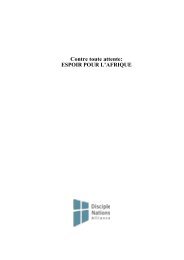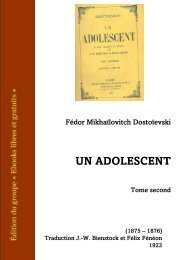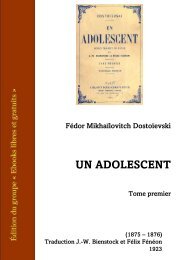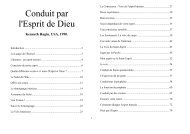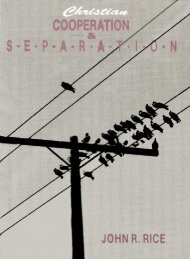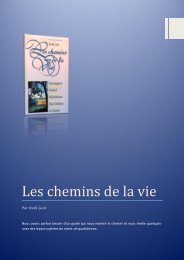Women writing in contemporary France
Create successful ePaper yourself
Turn your PDF publications into a flip-book with our unique Google optimized e-Paper software.
192 Transgressions and transformation<br />
The most strik<strong>in</strong>g change, however, consists <strong>in</strong> the <strong>in</strong>troduction of a<br />
degree of self-consciousness or reflexivity <strong>in</strong>to the novel. Prokop, now a<br />
publisher, is given a story written by his neighbour M. Slavik. The untitled<br />
autobiographical tale expla<strong>in</strong>s how M. Slavik came to realise that his dog<br />
was an angel sent by God to watch over him. In a reflexive gesture, the<br />
response to Prokop’s read<strong>in</strong>g of this unlikely narrative raises the issue of<br />
the relative conceptions of the nature of reality: ‘S’il n’avait pas connu monsieur<br />
Slavik, il aurait lu cette histoire comme une fiction’ (If he hadn’t<br />
known M. Slavik he would have read this story as a work of fiction), we are<br />
told, but M. Slavik ‘n’avait écrit que pour relater des faits qu’il jugeait réels’<br />
(p. 170) (had written only to relate facts which he judged to be true). The<br />
ontological status of ‘reality’ is itself <strong>in</strong> question; one man’s ‘reality’ is<br />
another’s fantastic. Furthermore, M. Slavik’s words to Prokop explicitly<br />
raise the problematic issue of reception: ‘Vous comprenez qu’il y aurait une<br />
grande impudeur à publier ces lignes qui ne pourraient que paraître ridicules<br />
à la plupart des lecteurs’ (p. 169) (You understand that it would be<br />
very unwise to publish these l<strong>in</strong>es which could only appear ridiculous to<br />
most readers).<br />
As a Christian novelist, it may be that Germa<strong>in</strong> faces an impossible<br />
task. The Christian po<strong>in</strong>t of view should ideally be seen to prevail, yet it<br />
must do so without alienat<strong>in</strong>g the non-believer, without the author’s present<strong>in</strong>g<br />
us with an open and closed case. As she herself po<strong>in</strong>ts out <strong>in</strong> Les<br />
Echos du silence, stasis and closure are the marks of closed m<strong>in</strong>ds: ‘Tout<br />
<strong>in</strong>tégrisme hait le mouvement’ (p. 36) (All fundamentalism abhors movement).<br />
The Christ of the resurrection, Germa<strong>in</strong> states, could only be represented<br />
by means of dynamic, open forms: ‘toute pe<strong>in</strong>ture où la force<br />
prime la forme, où le mouvement brise les lignes, où vibre la lumière, où la<br />
vitesse transfigure le visible’ (p. 45) (any pa<strong>in</strong>t<strong>in</strong>g <strong>in</strong> which force is more<br />
important than form, <strong>in</strong> which movement shatters l<strong>in</strong>e, <strong>in</strong> which light<br />
vibrates, <strong>in</strong> which speed transfigures the visible). By openly acknowledg<strong>in</strong>g<br />
the tw<strong>in</strong> issues of both reception and relative world-views by means of<br />
reflexive gestures to the reader, Germa<strong>in</strong> certa<strong>in</strong>ly does go some way<br />
towards open<strong>in</strong>g up her texts, but it may be that another, more <strong>in</strong>tractable<br />
problem rema<strong>in</strong>s: how can one describe the <strong>in</strong>effable?<br />
Statements which appear <strong>in</strong> her later novels acknowledge this<br />
dilemma too. In Immensités, comment<strong>in</strong>g on the state of m<strong>in</strong>d of those who<br />
succumb to despair, is a statement which ultimately seems to question the<br />
capacity of any art form to represent Christianity: ‘Ils avaient cru, ces deux<br />
êtres aux cœurs trop épris d’absolu, que la beauté, que le salut résidaient




